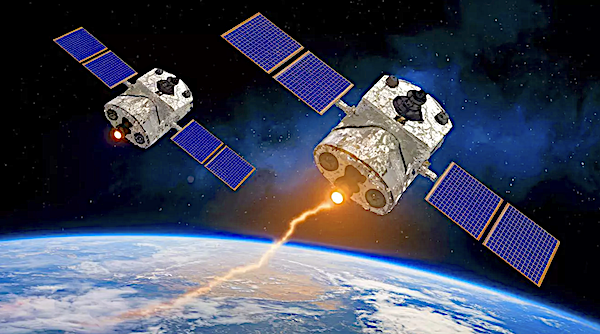
In an unprecedented development highlighting the escalating militarization of space, Chinese satellites have been observed conducting complex “dogfighting” maneuvers in low Earth orbit, a move that has prompted serious concerns from the United States Space Force about the potential implications for global security and stability.
The militarization of space has become a pressing issue, as evidenced by recent activities involving Chinese satellites engaging in tactical maneuvers in low Earth orbit. The concept of “dogfighting” in space, reminiscent of iconic science fiction narratives, is now a reality that the US Space Force is closely monitoring. These developments signal a shift from space being a peaceful domain to a potential battlefield among powerful nations. This article delves into the intricacies of these maneuvers, the technological advancements that enable them, and the broader implications for international space relations.
China’s Advanced Space Capabilities
In a recent gathering at the McAleese Defense Programs Conference in Washington, Gen. Michael Guetlein, Vice Chief of Space Operations, revealed that China is actively conducting military satellite maneuvers. These operations, observed by the US Space Force, involve synchronized movements of five different objects in space, showcasing a level of control and precision described as “dogfighting.” This term refers to the complex tactics, techniques, and procedures used in on-orbit operations from one satellite to another.
The key participants in these exercises include three Shiyan-24C experimental satellites, alongside the Shijian-605 A and B spacecraft. The ability to perform such advanced in-orbit maneuvers is a testament to China’s growing expertise in space technology. Notably, similar advancements are being pursued by global entities. For instance, Japan’s Astroscale has developed a satellite capable of matching the speed of space debris, an impressive feat considering debris travels at about 18,000 mph. Dr. Samantha Lawler, an astronomer, likens this technological prowess to “collecting bullets,” underscoring the sophistication required for such operations.
Establishing Space ‘Superiority’
The US Space Force’s pursuit of space superiority is driven by the narrowing technological gap between the US and its geopolitical rivals, particularly China and Russia. Gen. Guetlein highlighted past activities by Russia, such as the 2019 “nesting doll” demonstration, where a satellite released a smaller one to perform maneuvers near a US satellite, further emphasizing the need for the US to maintain its edge in space technology.
The US has long held a significant advantage in space capabilities, but this lead is under threat as other nations rapidly develop their technologies. Guetlein emphasized the necessity of re-evaluating the US approach to space operations to prevent the capability gap from reversing. The Space Force’s mission is to ensure that space operations support joint military efforts, aligning with the broader strategic goals of the US military. This shift in focus marks a departure from the principles of the 1967 Outer Space Treaty, which aimed to preserve space for peaceful exploration and scientific pursuits.
| Country | Notable Activity | Year |
|---|---|---|
| China | Dogfighting maneuvers with Shiyan-24C and Shijian-605 satellites | 2024 |
| Russia | Nesting doll demonstration releasing a smaller satellite | 2019 |
The Outer Space Treaty and Modern Challenges
The 1967 Outer Space Treaty represented a landmark agreement to maintain space as a domain for peaceful exploration and scientific advancement. However, the current trajectory of space militarization directly contradicts these ideals. The treaty’s principles are increasingly overshadowed by the strategic interests of powerful nations, each seeking an upper hand in space capabilities.
US Space Force officials have pointed fingers at China and Russia for accelerating this militarization. Conversely, these nations accuse the US of provoking an arms race in space. This cycle of blame highlights the complex geopolitical dynamics at play, where each side justifies its actions as necessary defensive measures. The treaty’s original vision of cooperative exploration now seems distant, as nations prioritize national security over collective scientific progress.
Implications for Global Security
The militarization of space has profound implications for global security and stability. As nations develop advanced space capabilities, the risk of conflicts extending beyond Earth increases. The potential for satellite confrontations or disruptions to vital global communication and navigation systems presents a significant threat to international peace.
The strategic importance of space assets cannot be overstated. They play a critical role in military operations, intelligence gathering, and civilian infrastructure. The growing competition in space reflects broader geopolitical tensions, where technological advancements are both a source of national pride and a potential catalyst for conflict. The question remains whether nations can navigate these challenges and find common ground to ensure space remains a domain for peace and progress.
The evolving landscape of space operations raises critical questions about the future of international relations and security. With nations like China and Russia pushing the boundaries of space technology, how will the US and its allies adapt to maintain balance? Will the original spirit of the Outer Space Treaty be revived, or will the cosmos become the next frontier of geopolitical rivalry?
From Sustainability by Darunee Sukanan
